An Attempt to Organize Thinking Patterns
Using "Kobo-chan" as an Example
(1) Metaphor
Contents
◆ Types of Thinking Patterns
Some of the actions that humans and animals take are based on thought.
Actions such as pulling back your hand after touching something hot or avoiding your face when something crosses in front of you are not based on thought. However, at least human culture and civilization are the results of the accumulation of thought-based behaviors.
The thinking patterns can organize as follows.
・Metaphor
・Analogy
・Induction
・Deduction
・Abduction (hypothesis formation)
This order is what I consider to be the order in which things do unconsciously. In general, the higher the order, the more unconscious it is, and the lower the order, the more conscious it is.
The sharpness of a person’s thinking will differ depending on whether or not they understand and can organize each of these basic thinking patterns. Furthermore, if you understand and organize these patterns, you will understand other people’s thinking patterns when arguing for ideas.
As I was thinking about how we could grasp these in an easy-to-understand way, I noticed examples of each thinking pattern in the yonkoma manga Kobo-chan (Kobo, the Li’l Rascal).
◆ Examples of Metaphor in Kobo-chan
For example, A seems to be a clear example of a ‘metaphor.’
A
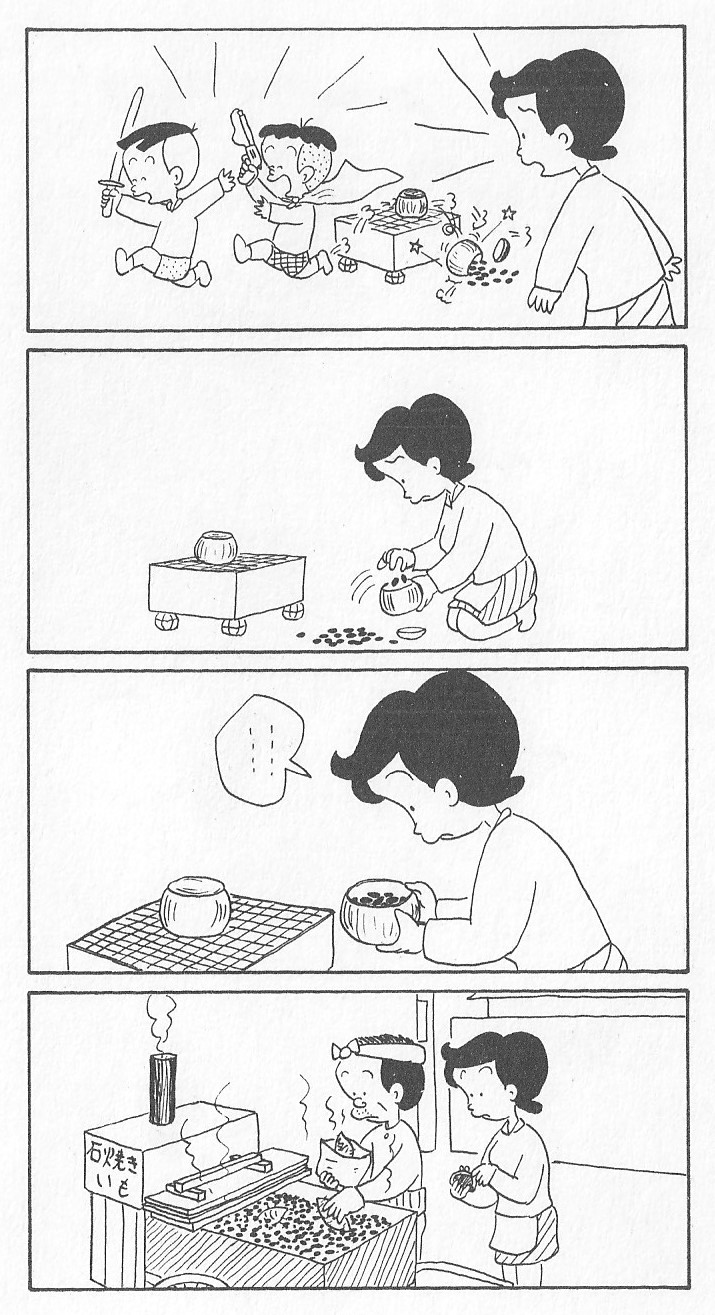
From Kobo-chan Masashi Ueda/Sōyō-sya
©UEDA Masashi
Kobo-chan’s mother, Sanae, picks up the ‘Go’ stones that her son has scattered while playing. As she looks at the black Go stones, she associates them with the stones used to roasted sweet potato in heat stones (Ishiyaki-imo石焼き芋) and goes to buy roasted sweet potato.
(Go is a board game in which players compete to secure a more extensive area using white and black stones, respectively.
Roasted sweet potato in heat stones is sweet potato baked in the far-infrared rays emitted from heated stones. In Japan, roasted sweet potato in heat stones is popular in the wintertime when they are sold by light trucks and carts.)
The process in Sanae’s mind can be described using ‘the logic of metaphor,’ Gregory Bateson called the ‘syllogism in grass,’ in addition to the formal syllogism:
Go stones are black and round;
Stones for roasted potato are black and round;
Go stones are stones for roasted potatoes.
When the mind perceives something, it generally divides it into the main part, ‘what it is,’ and the predicate part, ‘how it is.’ Metaphor is a thought that focuses on the commonality of predicates and links them together. Our minds think that “if the predicate is the same, then the main part is the same,” regardless of whether this is true or not.
The next one, B, is very similar to A.
B
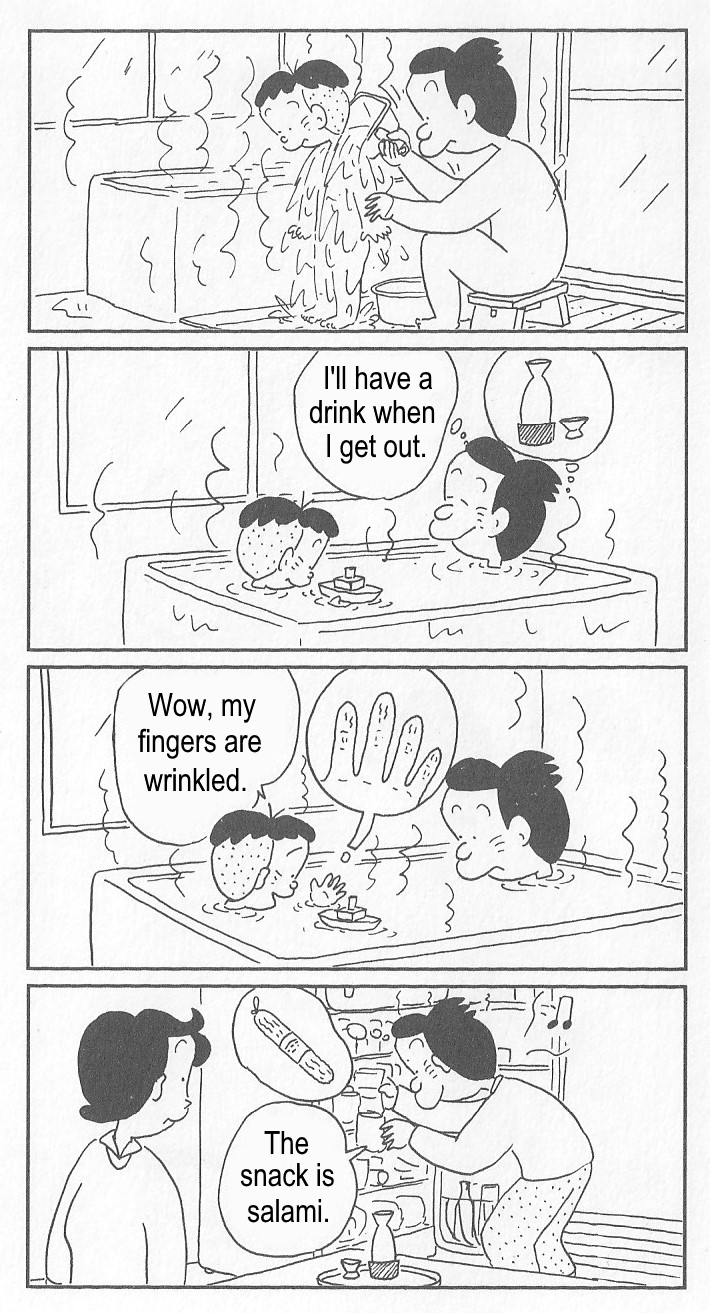
From Kobo-chan Masashi Ueda/Sōyō-sya
©UEDA Masashi
Koji, Kobo-chan’s father, looks at his son’s fingertips, which have become wrinkled while soaking in the bath. He associates the same wrinkled surface with salami and looks for salami as a snack to drink. A metaphor triggers that action. He would not be looking for salami afterward if he didn’t make a metaphor when he saw the wrinkled fingertips.
However, the thought must have been unconscious rather than conscious. Metaphor is a thought that goes on independently of the intervention of consciousness.
Some people may wonder whether metaphors can be called thoughts in the first place. For example, in linguistics and rhetoric, metaphor may be one of the rhetorical techniques. However, in my opinion, metaphors are thoughts that everyone subconsciously engages in, so communication between the sender and receiver is possible even when metaphorical expressions are used.
For example, “he is like a pig” is a ‘simile’ when there is information to indicate that it is a metaphorical expression, and “he is a pig” is a ‘metaphor’ when there is no information to indicate that it is a metaphorical expression.
Even when a metaphor is used, we usually instantly understand that it is a metaphor. This may be because metaphor is a thought that we all do even subconsciously.
The next C and D follow almost the same pattern as A and B. In C and D, the characters subconsciously associate food with what they see.
C
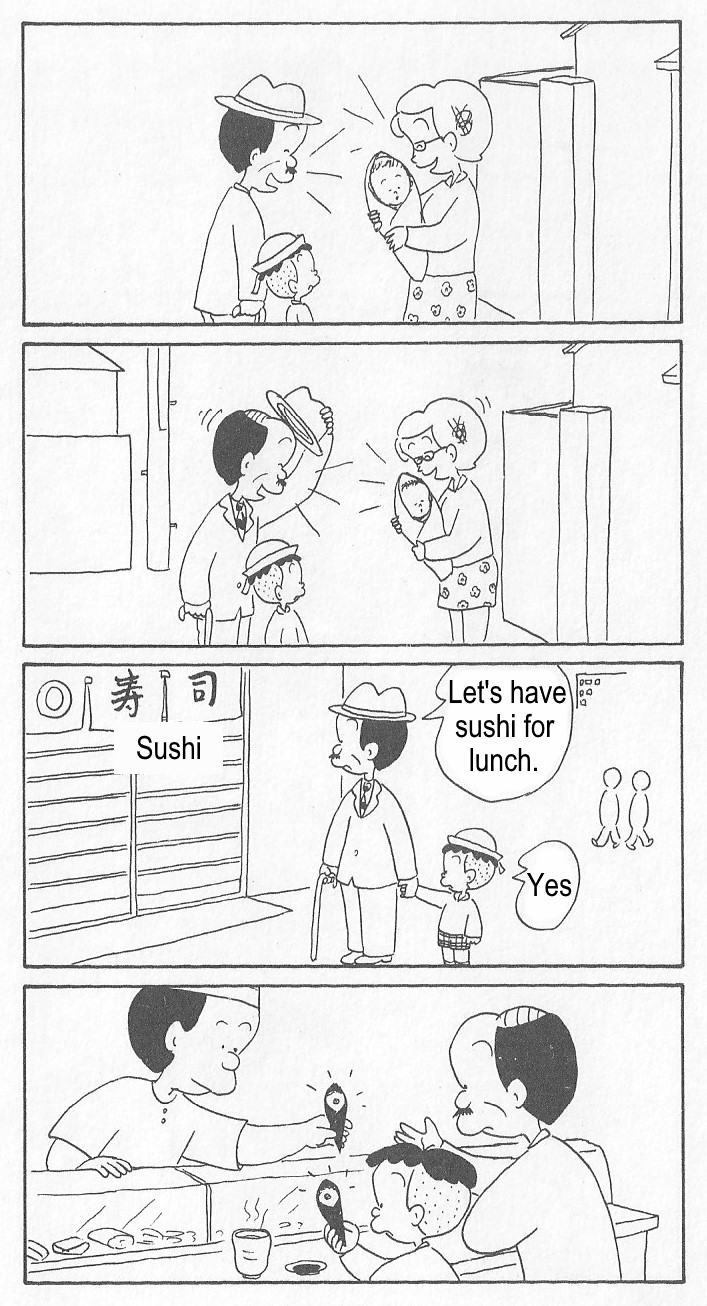
From Kobo-chan Masashi Ueda/Sōyō-sya
©UEDA Masashi
D
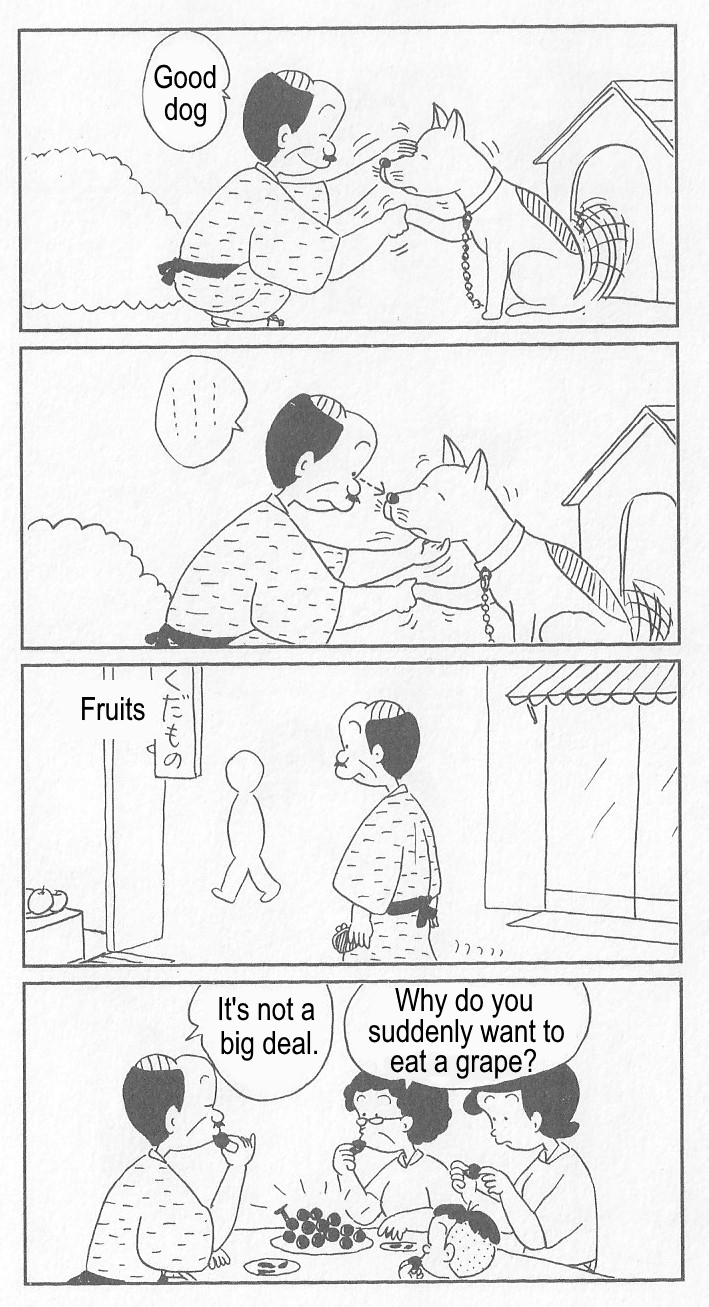
From Kobo-chan Masashi Ueda/Sōyō-sya
©UEDA Masashi
◆ “How to read” the Dream dictionary ‘Syllogism in Grass’
The dreams we have during sleep are truly unconscious activities. They are full of symbols. Symbolism is something that many of us commonly associate with metaphors.
For example, let’s say you see a dream that a snake appears, and you look it up in a dream dictionary to see what it symbolizes. Then it says, “Snakes are a symbol of life force.” If we look at this from a different angle, we can say the following:
The snake is strong and stubborn;
Anything that has a life force is strong and stubborn;
The snake is a life force.
So we can say that the unconscious mind connects the snake with the life force using the ‘syllogism in grass.’ In this sense, we can say that dream dictionary is a collection of only the conclusions of the ‘syllogism in grass’ without describing the process.
There are endless questions about what dreams are, but one ancient interpretation is the unconscious appealing to the conscious mind. However, then, why doesn’t the unconscious send direct messages to the conscious mind using language?
The reason for this seems to be that the unconscious does not have the language.
◆ Lévi-Strauss and Bateson The “Logic” of the Unconscious
However, structuralism and semiotics, which were once popular, claimed that there is a linguistic structure at the unconscious level. (It was not arguing that the unconscious has language, but it has the ‘structure’ of language.) Structuralism began with the anthropologist Claude Lévi-Strauss, but this may have been an idea typical of the French, who take pride in their language. On the other hand, for Gregory Bateson, language was a product of consciousness, not the unconscious. However, he thought that the unconscious must have its own “logic” different from the conscious.
This is where Lévi-Strauss and Bateson clearly differ. The former thinks that the structure of language is active even at the unconscious level, while the latter believes that the unconscious does not have language but has its own logic.
Bateson’s emphasis on metaphor is due to his belief that it is both unconscious and primitive.
While observing otters at a zoo in San Francisco, Bateson encountered a situation where they were clearly ‘playing.’ He observed a situation where the otters’ behavior could only be interpreted as metaphorical.
Dogs, for example, may bite a human or another animal seriously or softly. Serious biting would be a sign of caution or aggression. So what is the purpose of the soft bite? In Bateson’s opinion, that means “I’m not really biting you” or “I’m faking it,” which means “This is just for fun” or “Play with me or I’ll bite you for real.”
The coyote and cat in this video are clearly fighting for real.
On the other hand, the dog and cat in this video are clearly playing.
The dog bites the cat softly and the cat does not claw it.
Bateson emphasizes that the unconscious does not have ‘Not.’ Even if the unconscious wants to deny something, it can’t directly because it doesn’t have a negative sign as language does. So for the unconscious to deny something, it has to be ‘fake’ or lead us in a particular direction and then show us that it won’t work. Animals that do not have language also do not have ‘Not.’ So to deny that they are really biting, they need to show their fakes. Then, the dog’s sweet bite can be said to have a symbolic meaning.
In the first place, is there any practical or adaptive reason for sweet biting by animals? Do they press their teeth and gums against the body of another creature to clean their teeth or scratch their itchy gums? Or is it marking, such as scenting? If these behaviors do not have practical and adaptive meanings, then they may well have symbolic meanings.
◆ Metaphors and Communication
What appeared in the examples of Kobo-chan from A to D was a metaphor performed by an individual organism as a ‘thought.’ The sweet bite of a dog, on the other hand, is communication.
There are examples of communication using metaphor in Kobo-chan too.
For example, it is E.
E
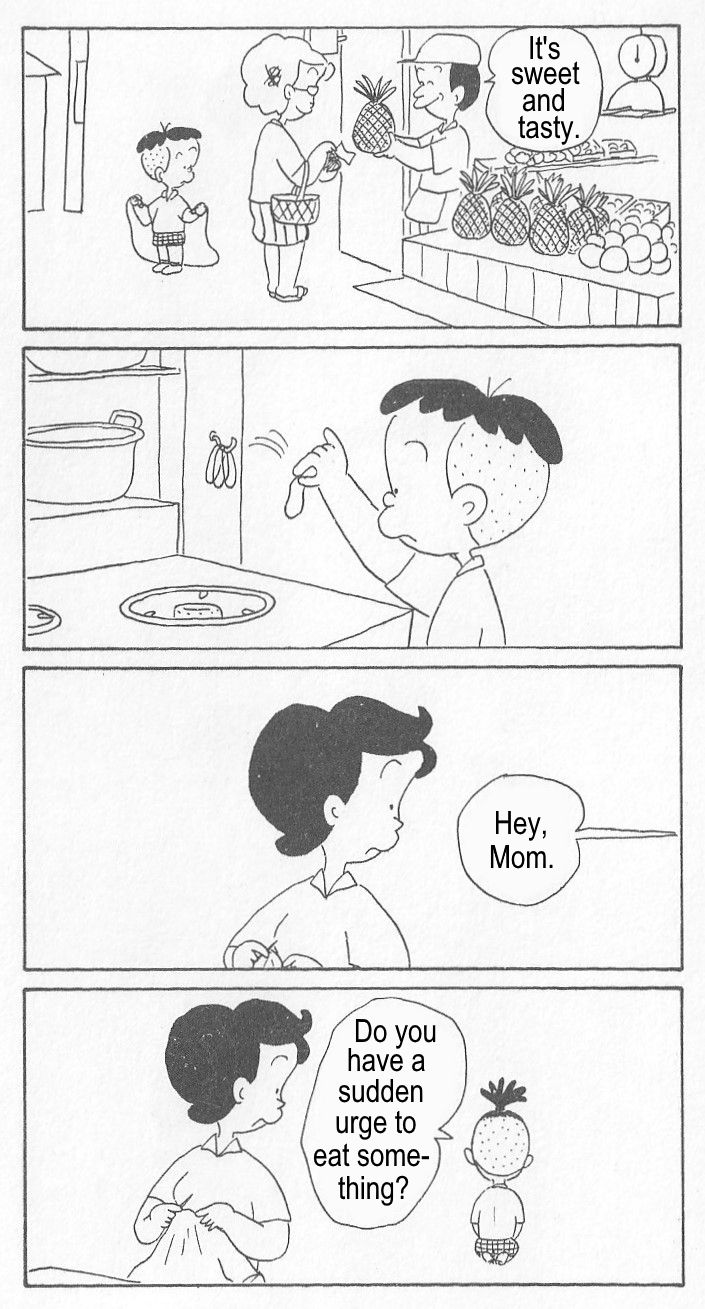
From Kobo-chan Masashi Ueda/Sōyō-sya
©UEDA Masashi
When Kobo-chan saw a woman buying a pineapple at a fruit store, he tied his hair up with a rubber band to get his mother to buy him a pineapple. At this point, Kobo-chan himself first connects the pineapple to his head with his hair tied up in a metaphor. Besides, now he hopes that his mother will see his head and associate it with pineapples through metaphor. We can say that Kobo-chan knows that metaphors take place unconsciously, even in his mother’s mind.
In the above examples A~D, the characters see something, unexpectedly associate food with it, and then actually eat or try to eat it. However, in this E, Kobo-chan is deliberately trying to get his mother to experience the pattern in A~D.
The other difference between E and A~D is that metaphor is also used to communicate in E for the first time.
Kobo-chan does not want his mother to see his head itself. If he had an injury or a boil on his head, he would like his mother to see the head itself, but that is not the case here.
It is essentially the same thing Kobo-chan is doing with a dog that bites us sweetly. Both are common in that they both want to communicate something other than what they are presenting themselves. Besides, the same is true for the expectation that the receiver will take it in that other sense.
◆ Humor and Pathology Layers of information
In light of the above discussion, we can see why metaphors can sometimes be humorous and morbid.
For example, let’s say Kobo-chan shows his head to his mother because he wants her to associate it with pineapples, but she finds a boil and takes him to the hospital. That would be humor. At that moment, the information Kobo-chan wanted his mother to interpret metaphorically was interpreted as it is.
On the other hand, let’s say Kobo-chan has a head injury and shows his head to his mother. Then, the mother thought metaphorically, ‘…His head looks like a watermelon. That makes me want to eat a watermelon. Let’s go to buy a watermelon.’ Further, if she leaves the injured Kobo-chan to go to buy a watermelon, that would be destructive in many ways. Of course, this would not be funny, and it would even be morbid.
We can say that information almost inevitably has a multilayered meaning, either directly or metaphorically. Besides, when information is sent out, the sender has certain expectations of the receiver. And when the receiver betrays that sender’s expectation, it becomes both humorous and morbid.
For example, the titles of novels and movies are full of metaphors. Few people, at least adults, would see a book titled The Silence of the Lambs in the novel section of a bookstore and interpret it as a literal description of the biology of sheep. In this case, the writer expects the reader to take the title metaphorically rather than literally.
However, things would be different if a book with the same title was found in the biology section. The book might really be about the biology of sheep.
This means that even in the same bookstore, we dexterously and almost unconsciously switch the title’s meaning from literal to figurative depending on the section. When we live in a world of multilayered information, it is vital to switch quickly and flexibly.
In the first place, can the sender of information reliably limit the information to either its ‘as-is’ or ‘metaphorical’ meaning?
For example, symbolic information, such as Morse code, is sent out to expect it to be received and decoded as is. However, in the end, it all depends on the receiver. If the meaning decoded from the signal is incomprehensible or unintelligible to the receiver, they will think, “Is this a metaphorical meaning rather than a literal one?”
On the other hand, suppose the sender intentionally sends information that is literally incomprehensible because they want it to be taken figuratively. However, the receiver may stubbornly try to interpret the information in a literal sense.
In other words, information is almost inevitably multilayered, and the possibility of discrepancies occurring within those layers cannot be eliminated.
◆ Metaphors in Religion Training Metaphor?
Religious rituals are full of metaphors. It is no exaggeration to say that metaphors support them. As Bateson illustrates, in the Christian mass, wine is given to the congregation as the “blood of Christ” and bread as the “body of Christ” by the clergy. According to one theory, it originated when Christ himself told his disciples at the so-called “Last Supper” that from now on, they should drink the wine as my blood and eat the bread as my body. Then, the clergy do not want the congregation to understand that they were given them as a mere meal but rather to take them in a figurative sense. Some denominations believe that they are not a metaphor but that the wine is the very blood of Christ and the bread is the very body of Christ. Here, the metaphor has become a completely unwritten rule and rigid. There is no freedom for the congregation to interpret the wine and bread as mere meals. If they want to interpret it that way, they have little choice but to leave the ritual.
Even if they are the same in terms of religion, there are several things in The Gateless Gate (Mumonkan), a collection of Rinzai-Zen koans, that seem to be examples of the exact opposite of that rigidity. The Gateless Gate is also full of metaphors, but they are mainly used to communicate rather than ritualize.
For example, “Buddha twirls a flower.”
A long time ago, when Shakyamuni Buddha was preaching on Grdhrakuta Mountain, he lifted a flower and presented it to the audience. All the people remained silent, but only the Maha-Kassapa smiled. Then Buddha said. “I have eyes that see the deep, hidden truth of righteousness, a mind of enlightenment that cannot be preached, and a mysterious true existence that cannot be seen with the naked eye because its form is aspectless. Let’s leave it to Maha-Kassapa in a different way, not in words or letters, not as a teaching, but in another way.”
Mumon said. “How self-indulgent the golden Buddha is! He takes good people and turns them into slaves, and then he sells them dog meat under the pretense that it is sheep meat. It’s not a trick that an ordinary person can do. However, if all the people in there had smiled at the same time, how would he have conveyed such a good thing as the Shōbōgenzō? On the other hand, how would he have communicated if he could not make Maha-Kassapa smile? In the first place, if it is possible to transmit something like the Shōbōgenzō, then the Buddha has seduced the public. If it cannot be sent, then why was it allowed to be sent only to Maha-Kassapa?”
say in a poem:
At a twisting a flower
The tail is out
You can’t even touch
To Maha-Kassapa’s smile
From The Gateless Gate translated by Eshin Nishimura
Iwanami-Bunko
This is a koan directly from the famous episode when Buddha nominated the successor of the religious organization. At this point, seeing Buddha holding up the flower, all of his disciples must have thought, “So what?” In other words, they would have known that Buddha’s actions were not meant to be as they were. If it were left as is, it would only mean “This is a flower,” or “This flower is beautiful,” or “It’s the season for this flower to bloom.”
There is an interpretation of this koan that Buddha communicated something to Maha-Kassapa through a kind of telepathy. However, if that were the case, the meaning of Buddha’s holding up the flower would be lost. Then again, it seems that Buddha’s actions can only be interpreted metaphorically. Besides, only Maha-Kassapa could understand the symbolic meaning, which is why he was the only one who smiled.
Mumon, explaining this koan, does not say that we should think about the meaning of that Buddha’s mysterious action. However, some koans clearly say so.
For example, “Nansen cut the cat.”
Nansen happened to come across a group of students living in the east and west halls of a Zen temple who were having trouble over a cat. He immediately snatched up the cat and said. “Come on, guys, try to say something. If you can say it well, you can save this cat, but if you can’t, I will cut this cat down.” Everyone could not say anything. Nansen had no choice but to cut down the cat. When his disciple Jōshū came back to the dojo from outside in the evening, Nansen told Jōshū about this incident. When he heard the story, Jōshū took off the sandals he was wearing, placed them on his head, and left the room. Nansen said, “If only you had been there, we could have saved that cat without complaint.”
Mumon said, “At any rate, tell me what the meaning of Jōshū putting the sandals on his head is. Nansen’s horrible thing will not be in vain if you can say something to show that. But if you can’t do that, then this is dangerous.”
say in a poem:
If there was a Jōshū
He would have done the complete opposite.
With his sword taken away
Even Nansen beg for his life.
From The Gateless Gate translated by Eshin Nishimura
Iwanami-Bunko
In this koan, Mumon writes to consider the meaning of that mysterious action by Jōshū. From a symbolic point of view, this is in opposition to the Christian denominations that believe wine to be the very blood of Christ, as mentioned earlier. The denominations teach that the result of a metaphor, in other words, what it symbolizes, cannot be anything other than what it is. Besides, they even equate symbols with things. On the other hand, Mumon does not tell us the result of the metaphor but tells us to do the metaphor yourself and get the answer.
That action by Jōshū is almost incomprehensible if we try to interpret it as it is. I don’t think Jōshū wanted to tell Nansen, “When it’s cold, you can put your sandals on your head to keep warm.” or, “I have such good balance that I can walk with my sandals on my head.”
We usually begin to think of symbolic meanings when we are presented with actions that do not make sense as they are. In other words, Jōshū is doing this because he expects Nansen to realize the metaphorical meaning of his actions. Besides, because Nansen has realized this, he says, “If only you had been there, we could have saved that cat without complaint.”
The following is just what I thought, so-called “Yako-Zen野狐禅,” but it may be of some help to you.
Nansen picked up the cat and said, “Try to say something. If you can say it well, you can save this cat, but if you can’t, I will cut this cat down.” However, his disciples were silent, so he slew the cat. But in The Gateless Gate, other koans repeatedly emphasize that one should not speak in words, but one should also not be silent. If that is the case, Nansen should give a low rating to the disciples’ speaking and silence and give a higher rating to the symbolic message without words. In other words, isn’t what he asked the disciples to do inverted? However, if the claim that it is important to use non-verbal metaphors is expressed in language, the content of the claim and the means of expression do not match. That’s why Jōshū expressed the above argument metaphorically, without using language, by placing the sandals on his head, which were initially worn on our feet.
Regardless of whether this interpretation is correct or not, one thing that can be said is that the essence of the action taken by Jōshū is the same as Kobo-chan in E mentioned above. Just as Kobo-chan didn’t want her mother to see the head itself, Jōshū didn’t wish Nansen to see the head itself with the sandals on it.
However, why does Rinzai-Zen emphasize metaphors so much?
One hypothesis is that we can know the wisdom in enlightenment through metaphors, which would explain a lot. As I have written many times, we do metaphors unconsciously. The answer of sorts, “the snake is the life force,” was also tied up in the unconscious. Then the wisdom of enlightenment may also come in the form of the unconscious connecting something to something else. If, for example, the unconscious gets the answer to the question “what is the true self?” through metaphors, it explains why Zen stresses the need to destroy consciousness and why consciousness can suddenly feel that it has the answer.
Since anyone can use metaphors, even unconsciously, it is difficult to think of ‘training’ them. However, Rinzai-Zen seems to be trying to train it by working on koans. Some things, such as those summarized in the dream dictionary, result from metaphors anyone can make. However, if we assume that some things can be connected only when metaphors are trained, we can explain the emphasis on metaphors in Rinzai-Zen.
Then metaphors are unconscious, primitive, universal, and even more so, ultimate thought patterns.
I first explained metaphor in basic thinking patterns. Next, I am going to explain the analogy.
2021 8/18
◯References
Translated by Eshin Nishimura The Gateless Gate Iwanami-bunko, 1994.
Amazon.jp
◯Bibliography
Bateson. G and Bateson. M. C. Angels Fear: Towards an Epistemology of the Sacred New York: Macmillan, 1987.
Amazon.com
※The content, text and images are prohibited to reproduce, quote or use in any way other than for correct quotation.






